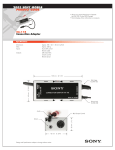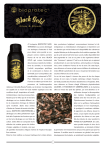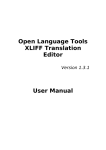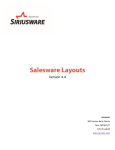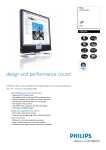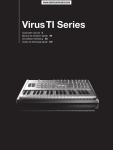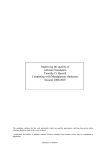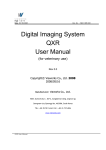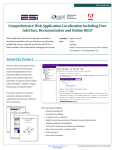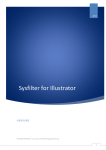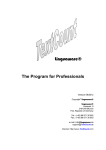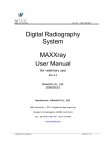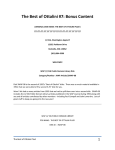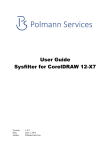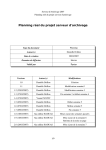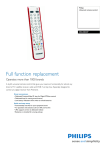Download Déjà Vu X Professional - Just Right Communications
Transcript
Déjà Vu X Professional: A Review of Version 7.5, Part II By Naomi de Moraes In August, this reviewer began a discussion of the features offered by the translation memory tool Déjà Vu X (DVX) Professional. The segment covered how to get started with a project, the translation/editing work environment, keyboard shortcuts, DVX offer? • Is DVX stable (will it crash, or worse yet, crash my PC)? This article is one in a series of translation tool reviews, and does not represent an endorsement by ATA. All opinions are solely those of the author One of DVX’s best features is its automatic terminology lookup. and how to use DVX when you work with others who do not have it on their system. This month, readers will learn about some of the more advanced features in DVX. The following questions will be addressed: • Is the terminology database and translation memory database well integrated with the DVX translating environment? • What file formats and other tools can DVX work with? • What quality control features does The ATA Chronicle ■ September 2007 (see the June and July articles “Taking the Plunge” for a discussion of tool types and which are best for which situations). Integration of the Terminology Database with the DVX Translating Environment Automatic Terminology Lookup: One of DVX’s best features is its automatic terminology lookup. This function parses all the words in the source text and looks for them in the terminology database (TD), the translation memory (TM), and the project lexicon. The results are numbered and color-coded by source, as shown in Figure 1 on page 34. You can then insert a word or phrase from the results into your translation by typing Ctrl plus the number that appears next to the entry. For example, typing Ctrl+8 from the results listed in Figure 1 would insert the phrase insured vehicle. One weakness of this feature is the inability to change the case of the word to be inserted. For example, in Figure 1, typing Ctrl+6 would insert the word PREMIUM. I would then need to select the word and hit the key combination Shift+F3 twice in order to have the word appear in lowercase letters. Therefore, it would be just as fast to type premium in lowercase letters. However, having the word appear on the screen is a nice reminder in case my memory fails. Note that DVX does not mark the source text in the left column in any way to show that the terminology is in the databases. You must glance over at the AutoSearch window, and sometimes I forget to look. Fortunately, DVX’s quality control features (discussed here) can help you maintain consistent terminology after the translation is complete. ➡ 33 Figure 1: Déjà Vu X environment showing automatic terminology lookup Figure 2: Déjà Vu X AutoSearch window showing an excessive number of matches Fuzzy Lookup: You can tell DVX to use fuzzy terminology searching, which is helpful for languages with some morphology, but I doubt it would work very well for languages with many suffixes or prefixes, like Hungarian. Unfortunately, you can sometimes end up with far too many options, as shown in Figure 2. In this offered by DVX is the ease with which terms can be entered into the TD or lexicon. The lexicon is a feature I have seen only in DVX, and it allows you to create a TD that is specific to the project you are working on. This is great for frequently repeated terms, such as product names, company names, or anything for which you might create an AutoText entry in MS Another nice DVX feature is the ease with which terms can be entered into the terminology database or lexicon. case, definitions and description are both very common headers/titles, so I have many identical entries in my TM. The only question is why DVX needs to show them all! I would think that the program would be able to recognize identical entries. These extra entries could be removed manually, but I rarely have the time to do this when working. Entering Terms: A very nice feature 34 Word. For example, in Figure 1, I had added the term insured vehicle to the lexicon. I do not need this entry to help me remember the term, but typing Ctrl+8 is much quicker than typing insured vehicle 500 times in an auto insurance contract. The lexicon is also handy when a specific client wants you to use one particular term that you normally do not use. You can add the term to that project’s lexicon, and you will not even The ATA Chronicle ■ September 2007 Figure 3: Déjà Vu X Add Term Pair window see it when working on projects for other clients. Another advantage is that, to add a term and its translation to the lexicon, you just select the term in each language on the screen and click on the “Add Pair to Lexicon” button, or else use the keyboard shortcut to add it to the lexicon with no additional steps. You can also add terms to the TD in a similar manner by selecting the two terms in the source and target columns and typing F11. This causes the window shown in Figure 3 to appear. DVX fills in the context sentence automatically, and you can modify the term attributes or ignore them. and MS Excel. A wizard (an interactive help utility) leads you through the process. The DVX user manual explains how to export MultiTerm databases (an SDL International product) so they can then be imported by DVX. It can also Building a Source-language Lexicon: Another handy feature of DVX is the ability to build a source-language lexicon automatically. DVX will search the source documents for recurring terms and provide a complete list. This is helpful for defining terminology in advance when working with colleagues on a project, or if you like to do all your research first. Note that this feature is a simple text parser. It includes every single word and word combination, with no attempt to recognize what a translator would consider a term. Sorting according to the number of occurrences and the number of words per term helps reduce the list to a manageable size. You can also import terminology from other formats, including tab/comma delimited files, MS Access, export terms to these and other formats. See the DVX site for more information. DVX Professional, the version reviewed here, lets you use two TDs while working on a project and define read/write privileges for each. DVX also provides a separate sub-application for editing the TD, but you can edit entries in the AutoSearch window by right-clicking on them. The ATA Chronicle ■ September 2007 the new source text). The word revogação and its translation are also in the database, probably because it was a title in the document. DVX recognizes that the word that changed is in the database and automatically assembles the translation for the new source segment. DVX can also assemble target segments from bits and pieces taken from the different databases, if configured, but this is not very useful when the source and target languages have different word order rules. Note that the window in the bottom right corner of Figure 4 shows the words in the new source text that are different from the previous translation for easy recognition (in red and with strike- DVX’s quality control features can help you maintain consistent terminology after the translation is complete. Integration of the Translation Memory Database with the Translating Environment DVX has a special feature called Assemble. For example, in Figure 4 on page 36, the sentence to be translated differs from a sentence already translated by just one word (reversão in the prior translation, revogação in through font). One weakness of DVX is that it does not show number and formatting code changes clearly, or, rather, it does not highlight them at all. Figure 5 on page 36 shows an example in which the only difference between the source text and the text stored in the TM has to do with numbers (which DVX will automatically assemble for you). A tiny number in the bottom right corner indicates that the match is not 100%, but you must read the two source segments in their entirety to figure out what changed. I find this extremely frustrating, since I feel it would be very helpful for DVX to highlight the numbers that have changed. Sometimes DVX does not find things I think it should, per➡ 35 Figure 4: Déjà Vu X environment showing automatic assembly Figure 5: Déjà Vu X AutoSearch window showing number difference haps because only a part of the sentence is exactly the same or the codes are different. You can select the text in the source cell and click on Scan (Ctrl+S) to look up that text in the entire TM. This will call up another window with the closest occurrences, which you can then choose to insert, either in whole or in part. Most, if not all, envi- 36 ronment tools have this feature. DVX can import and export TMs from/to many other formats, including the standard exchange format TMX. It also propagates translations of segments within a given project, which are marked as such (and can thus be relied upon more than a segment from another, older source file stored in the database). The professional version of DVX lets you use two different databases and control read/write permissions for each separately. TMs are automatically bi-directional, so if you translate in both directions in a language pair, you can use just one database. However, you can tell DVX to use translations only in the direction The ATA Chronicle ■ September 2007 Figure 6: Déjà Vu X Alignment Wizard in which they were originally added to the TM for a given project. Unwanted TM entries can be removed from the database using the AutoSearch window (right-click, then delete), or by using a separate sub-program to edit the database. Compatible File Formats and Tools DVX can import many different file types, including MS Office 2007 documents on Windows Vista, RTF, HTML, SGML/XML, FrameMaker, PageMaker, OpenOffice 2.0, QuarkXPress, Adobe InDesign, Trados Word/RTF files, Trados TagEditor files, TMX, and various programming formats. (See the DVX website for more details.) You can often translate these file types without having the program that created them, but the formatting may come out funny. This is because one language occupies more space than the other, and is not due to any error on the part of the tool. Therefore, I would not recommend sending the exported files without opening them and looking them over The ATA Chronicle ■ September 2007 in their native program, unless the client specifically states that he will do the formatting for you. DVX can import pre-processed SDL Trados RTF/DOC files and SDL Trados TagEditor files, even if you do not have SDL Trados. Of course, someone needs to pre-process the files for you. Just be sure to read the manual carefully before you import the files, because it is a bit tricky. I just wish DVX could import a regular MS Word file and output an SDL Trados file when clients request one. Like most tools, DVX has an internal alignment tool that will let you align translations done outside the tool and add them to the TM. You must tweak the alignment a bit to make everything fit, but the interface is relatively simple, as shown in Figure 6. You can insert the cursor anywhere in the source or target text to break up segments when necessary. The example text in Figure 6 is one where the punctuation and style in the two languages were very different. Note that you can also join and split segments in the translating environment. Quality Assurance DVX has some interesting quality assurance features in addition to spell check. Even the spell check feature allows you to use the built-in dictionary or the MS Word spelling dictionaries. Unfortunately, I have found that the built-in dictionary is weak when it comes to Portuguese, so I have a special program for checking Portuguese grammar called FLiP. The program has special spelling dictionaries and is integrated into the MS Word interface, so it takes over MS Word’s spelling and grammar check. FLiP does not work with DVX, so I export my translations into “external view” (see the first part of this review in the August issue) to take advantage of this tool, or similar tools for other languages. An additional quality assurance feature checks that numbers in the source text also appear in the translation, and that terminology ➡ 37 Déjà Vu X Professional: A Review of Version 7.5, Part II Continued present in the source text and found in the lexicon or TD is translated according to the lexicon/TD entries. I have found that checking terminology against the TD is not very useful unless I use a special TD for the project (great for software or computer manuals), or unless I check just against the project lexicon. The DVX feature not only marks the cells where it finds discrepancies, but it even tells you why they are marked in a comment. DVX also has a great feature that searches for duplicate source sentences in a project with different translations. When reviewing text, if you change the translation of a repeated source segment, you might not realize you need to change the translation in identical segments for consistency. DVX helps you find these instances. One quality assurance feature I find rather annoying is that DVX will not let you export the translation (even to “external view”) unless all the cells are filled in. Sometimes I like to export a translation and look it over in a different program before it is complete, or use the FLiP tool mentioned above, especially when it is a very large project. In these cases, you can either use the “populate” function to populate the empty cells with the source text (on a backup copy, since this action cannot be undone), or break the large file into smaller files before importing them into DVX. I would not mind if DVX made me close two warning windows before letting me export a file that has not been translated completely, since at least then I would be able to share my partially translated file with colleagues/editors who do not have DVX. Stability One difference between DVX and some other tools is that there is no Save button. Every segment is saved as you type. Thankfully, there is an 38 Grammar and Spell Check Software FLiP 5 – Ferramentas para a Língua Portuguesa www.flip.pt German: Duden Korrektor www.duden.de/produkte/ index.php?nid=83 French: Antidote RX www.druide.com English: StyleWriter www.writersupercenter.com/ stylewriter/index.htm Spanish: El Corrector www.documens.com I have not used the programs mentioned above (except for FLiP), so please let me know if they are useful, or if there is a good program for your language, so I can mention it in a future review. Please contact me at [email protected]. undo button (older versions did not have this!). DVX also lets you download free program updates, although some updates have had more bugs than others. There have been times when DVX has crashed, but I have never lost any data, and it has never failed to export a file it imported. Every single translation environment program that I have ever used has crashed, some more than others. DVX does let you back up project files as insurance against hard drive crashes, viruses, etc. Like many environment tools, DVX has been known to balk when asked to import large files with many images. The only option has been to remove the images before importing, then paste them back into the translation. Formatting almost always comes out as expected, unless two tags are reversed (e.g., the unbold tag comes before the bold tag, with the entire remainder of the file exported as bold). I have not had much luck when working with an MS Word file that contains internal links or links to websites. These do not usually appear correctly after export, so they must be checked manually. Miscellaneous One feature of DVX that I miss most when using some other environ- ment tools is having statistics on how many words in the source text I have translated. I often work on large projects and pace myself by defining word goals for each day so I do not get behind. DVX helps me keep track with the word count feature (Ctrl+W). Different Déjà Vu X Versions DVX has several different versions with varying prices, and a free version called DVX Editor. This free version works only on satellite files created by the most expensive version (Workgroup), and does not contain most of the features that make DVX useful. There is also a standard version, listed on www.atril.com for $668, but it does not have AutoSearch, AutoPropagate, or AutoAssemble. In my experience, Déjà Vu X Professional 7.5 ($1,349 on www.atril.com) is a good, stable, and well-rounded environment tool. References Déjà Vu X Professional Version 7.5.302 www.atril.com FLiP 5 – Ferramentas para a Língua Portuguesa www.flip.pt The ATA Chronicle ■ September 2007






